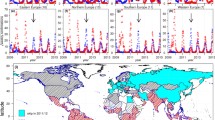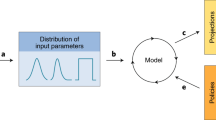Abstract
Evolution of the industrialized society had led to a risk management policy in many domains. Assessment of health care risk in the case of infectious diseases often includes mathematical models. Results of modelling were used in France to design emergency plans against flu pandemic. We believe that models cannot predict the features of the future outbreaks because the intrinsic properties of an emergent pathogen and the ecosystem in which it is developing are very complex. Of course, prediction of future outbreaks is not possible without using models, but we think that it is an illusion to presently believe that an emerging phenomenon can be anticipated by using only prediction from models. The recent pandemic caused by the novel A/H1N1 virus has confirmed the unpredictability of infectious diseases. The rapid evolution in several domains such as antimicrobial therapeutics, vaccine and hygiene conditions make comparison with past pandemics hard. The adherence of populations to prevention measures and immunisation campaigns are unpredictable. In addition, the presentation of pessimistic models is deleterious. They impress governments and provoke fears. There is a striking necessity to develop the number and the capacities of sentinel centres to take and adapt decisions based on timely available scientific information.
Similar content being viewed by others
References
Secrétariat général de la défense nationale (république française). Plan national de prévention et de lutte « pandémie grippale » n° 150/sgdn/pse/pps du 20 février 2009. Available:http://www.Pandemie-grippale.Gouv.Fr/img/pdf/plan_pg_2009.Pdf. Accessed on 4 Nov 2007.
Dowell SF. Seasonal variation in host susceptibility and cycles of certain infectious diseases. Emerg Infect Dis. 2001;7:369–74.
Lipsitch M, Viboud C. Influenza seasonality: lifting the fog. Proc Natl Acad Sci USA. 2009;106:3645–6.
Lofgren E, Fefferman NH, Naumov YN, Gorski J, Naumova EN. Influenza seasonality: underlying causes and modeling theories. J Virol. 2007;81:5429–36.
Casalegno JS, Ottmann M, Duchamp MB, Escuret V, Billaud G, Frobert E, Morfin F, Lina B. Rhinoviruses delayed the circulation of the pandemic influenza a (h1n1) 2009 virus in france. Clin Microbiol Infect. 2010;16:326–9.
Linde A, Rotzen-Ostlund M, Zweygberg-Wirgart B, Rubinova S, Brytting M. Does viral interference affect spread of influenza? Euro Surveill. 2009;14:19354.
Hancock K, Veguilla V, Lu X, Zhong W, Butler EN, Sun H, Liu F, Dong L, DeVos JR, Gargiullo PM, Brammer TL, Cox NJ, Tumpey TM, Katz JM. Cross-reactive antibody responses to the 2009 pandemic h1n1 influenza virus. N Engl J Med. 2009;361:1945–52.
Miller E, Hoschler K, Hardelid P, Stanford E, Andrews N, Zambon M. Incidence of 2009 pandemic influenza a h1n1 infection in england: a cross-sectional serological study. Lancet. 2010;375:1100–8.
Nougairede A, Ninove L, Zandotti C, Salez N, Mantey K, Resseguier N, et al. Novel virus influenza a (h1n1sw) in South-Eastern France, April–August 2009. PLoS One. 2010;5:e9214.
Intensive-care patients with severe novel influenza a (h1n1) virus infection-michigan, June 2009. MMWR Morb Mortal Wkly Rep 2009;58:749–752.
Vaillant L, La Ruche G, Tarantola A, Barboza P. Epidemiology of fatal cases associated with pandemic h1n1 influenza 2009. Euro Surveill. 2009;14:19309.
van den Brand JM, Stittelaar KJ, van Amerongen G, Rimmelzwaan GF, Simon J, de Wit E, Munster V, Bestebroer T, Fouchier RA, Kuiken T, Osterhaus AD. Severity of pneumonia due to new h1n1 influenza virus in ferrets is intermediate between that due to seasonal h1n1 virus and highly pathogenic avian influenza h5n1 virus. J Infect Dis. 2010;201:993–9.
Morens DM, Taubenberger JK, Fauci AS. Predominant role of bacterial pneumonia as a cause of death in pandemic influenza: implications for pandemic influenza preparedness. J Infect Dis. 2008;198:962–70.
Niffenegger JP. Proper handwashing promotes wellness in child care. J Pediatr Health Care. 1997;11:26–31.
Roberts L, Smith W, Jorm L, Patel M, Douglas RM, McGilchrist C. Effect of infection control measures on the frequency of upper respiratory infection in child care: a randomized, controlled trial. Pediatrics. 2000;105:738–42.
Luby SP, Agboatwalla M, Feikin DR, Painter J, Billhimer W, Altaf A, Hoekstra RM. Effect of handwashing on child health: a randomised controlled trial. Lancet. 2005;366:225–33.
MacIntyre CR, Cauchemez S, Dwyer DE, Seale H, Cheung P, Browne G, Fasher M, Wood J, Gao Z, Booy R, Ferguson N. Face mask use and control of respiratory virus transmission in households. Emerg Infect Dis. 2009;15:233–41.
Aiello AE, Murray GF, Perez V, Coulborn RM, Davis BM, Uddin M, Shay DK, Waterman SH, Monto AS. Mask use, hand hygiene, and seasonal influenza-like illness among young adults: a randomized intervention trial. J Infect Dis. 2010;201:491–8.
Cowling BJ, Fung RO, Cheng CK, Fang VJ, Chan KH, Seto WH, Yung R, Chiu B, Lee P, Uyeki TM, Houck PM, Peiris JS, Leung GM. Preliminary findings of a randomized trial of non-pharmaceutical interventions to prevent influenza transmission in households. PLoS One. 2008;3:e2101.
Christenson B, Lundbergh P, Hedlund J, Ortqvist A. Effects of a large-scale intervention with influenza and 23-valent pneumococcal vaccines in adults aged 65 years or older: a prospective study. Lancet. 2001;357:1008–11.
Kwong JC, Stukel TA, Lim J, McGeer AJ, Upshur RE, Johansen H, Sambell C, Thompson WW, Thiruchelvam D, Marra F, Svenson LW, Manuel DG. The effect of universal influenza immunization on mortality and health care use. PLoS Med. 2008;5:e211.
Nichol KL, Lind A, Margolis KL, Murdoch M, McFadden R, Hauge M, Magnan S, Drake M. The effectiveness of vaccination against influenza in healthy, working adults. N Engl J Med. 1995;333:889–93.
Nichol KL, Margolis KL, Wuorenma J, Von Sternberg T. The efficacy and cost effectiveness of vaccination against influenza among elderly persons living in the community. N Engl J Med. 1994;331:778–84.
Nichol KL, Nordin J, Mullooly J, Lask R, Fillbrandt K, Iwane M. Influenza vaccination and reduction in hospitalizations for cardiac disease and stroke among the elderly. N Engl J Med. 2003;348:1322–32.
Nichol KL, Nordin JD, Nelson DB, Mullooly JP, Hak E. Effectiveness of influenza vaccine in the community-dwelling elderly. N Engl J Med. 2007;357:1373–81.
Reichert TA, Sugaya N, Fedson DS, Glezen WP, Simonsen L, Tashiro M. The japanese experience with vaccinating schoolchildren against influenza. N Engl J Med. 2001;344:889–96.
Nougairede A, Lagier JC, Ninove L, Sartor C, Badiaga S, Botelho E, Brouqui P, Zandotti C, De Lamballerie X, La Scola B, Drancourt M, Gould EA, Charrel RN, Raoult D. Likely correlation between sources of information and acceptability of a/h1n1 swine-origin influenza virus vaccine in marseille, france. PLoS One. 2010;5:e11292.
Herroelen L, de Keyser J, Ebinger G. Central-nervous-system demyelination after immunisation with recombinant hepatitis b vaccine. Lancet. 1991;338:1174–5.
Lee JW, Melgaard B, Clements CJ, Kane M, Mulholland EK, Olive JM. Autism, inflammatory bowel disease, and mmr vaccine. Lancet. 1998;351:905.
Raoult D. Rapport sur le bioterrorisme. France: Ministère de la santé de la famille et des personnes handicapées; 2003.
Author information
Authors and Affiliations
Corresponding author
Rights and permissions
About this article
Cite this article
Nougairède, A., Charrel, R.N. & Raoult, D. Models cannot predict future outbreaks: A/H1N1 virus, the paradigm. Eur J Epidemiol 26, 183–186 (2011). https://doi.org/10.1007/s10654-010-9533-6
Received:
Accepted:
Published:
Issue Date:
DOI: https://doi.org/10.1007/s10654-010-9533-6




